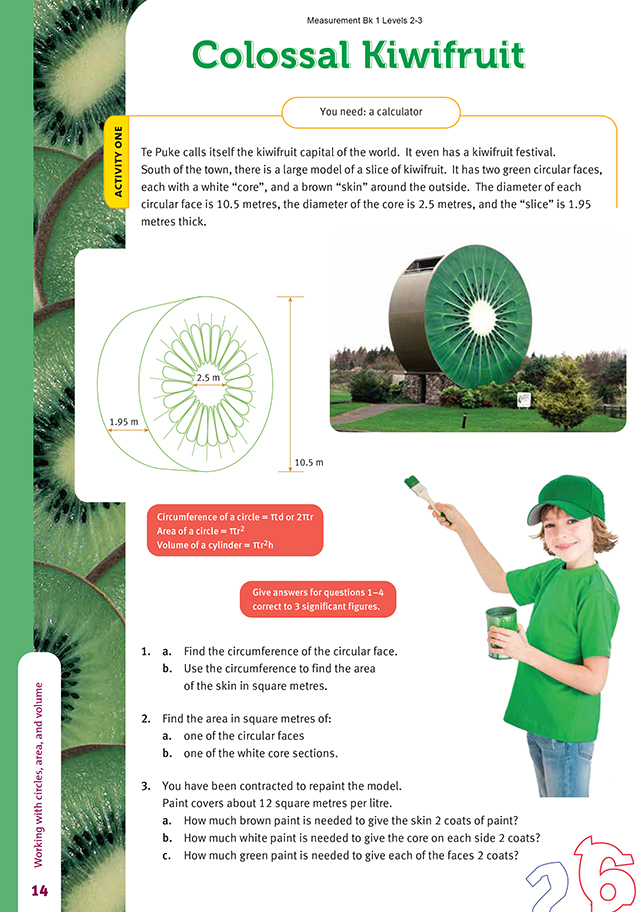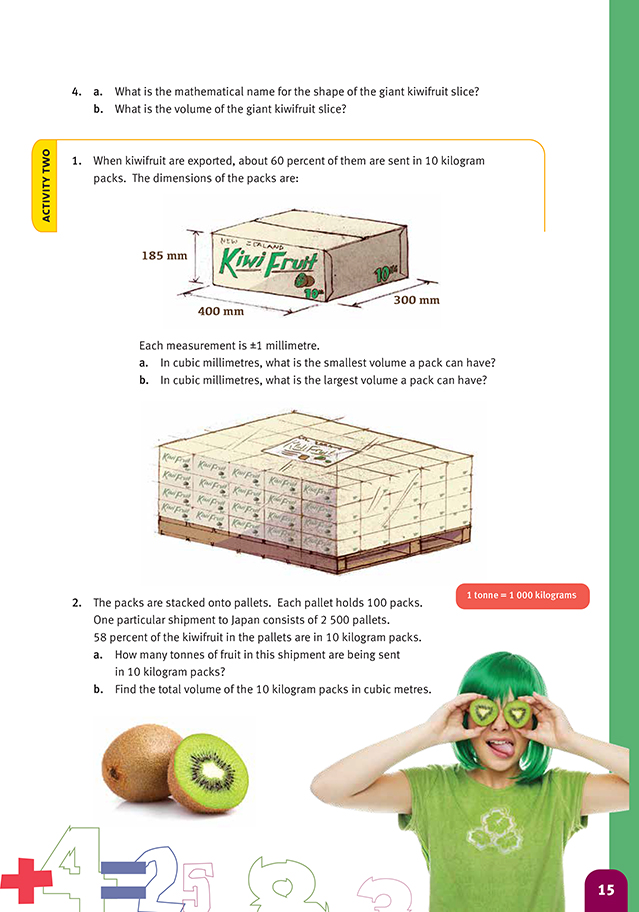Colossal Kiwifruit
This is a level 5 measurement strand activity from the Figure It Out series.
A PDF of the student activity is included.
Click on the image to enlarge it. Click again to close. Download PDF (279 KB)
find the circumference and area of a circle
find the area of a cylinder
fidnt he volume of a cuboid
FIO, Level 4+, Measurement, Book Two, Colossal Kiwifruit, pages 14-15
calculator
Activity one
In this activity, the students work with the circumference and area of circles and the volume and weight of boxes, all in a kiwifruit context. They are asked to round numbers using significant figures and to work with specified limits of accuracy. This may be the first time that your students have come across the need for these skills.
Of all the methods of rounding, rounding by significant figures is perhaps the most useful. It is also the most difficult to fully understand, mainly because zeros are sometimes significant and sometimes not. To round a number to 3 significant figures: begin at the left-hand end of the number and read along to the right until you come to the first non-zero digit. This is the first significant figure. The next two digits (even
if they are zeros) are the second and third significant figures. Remove all the remaining digits (after the third significant figure), but before doing so, check the fourth digit. If it is 5 or more, add 1 to the third digit.
Replace any digits between the third significant figure and the decimal point with zeros. (In the examples below, these zeros are italicised.) In each case, the bold digits are the first 3 significant figures.
Examples:
- 3.141592654 = 3.14 (3 sf)
- 0.00523142 = 0.00523 (3 sf)
- 904 618 342 = 905 000 000 (3 sf)
- 0.00007138922 = 0.0000714 (3 sf)
- 11 392 = 11 400 (3 sf)
- 47.9877 = 48.0 (3 sf)
- 15 001 784=15 000 000 (3 sf)
For many students, the hardest part of the rounding process is understanding the role of the zeros of the kind that have been italicised here. They are place holders and ensure that the original number is rounded, not reduced or increased by a factor of 10. Note that, apart from the zero that is usually put in front of a decimal point when the number is greater than -1 and less than 1, zeros are never optional when rounding by significant figures. They are either necessary or wrong.
When doing the various parts of this activity, the students should set out the processes on paper but do all the calculations with a calculator. They should also use the &pi:; key on their calculator rather than the approximation 3.14. If they don't do this, their answers will be slightly different from those in this book.
When doing question 3, some students may forget that the kiwifruit has 2 sides and needs 2 coats of paint.
For each part, the students need to find the area, multiply by 2 (coats), multiply by 2 (sides) if appropriate,
and then divide by 12 to get the amount of paint needed.
Activity Two
Before the students start this activity, you should specifically explain the limits of accuracy concept. It is not something that they are likely to be able to work out for themselves.
The basic idea is that no measurement is exact. While measurements can be as precise as our instruments permit, they can never be perfect. For example, a skilled cabinetmaker is able to measure and cut materials to the nearest millimetre but no more. You can't read tapes and rules to the nearest tenth of a millimetre.
This means that when carpenters say a piece of wood is 422 millimetres long, they mean that it is closer to 422 than to 421 or 423. 422 millimetres therefore includes every measurement from 421.5 up to, but not including, 422.5. This is normally written 421.5 ≤ length < 422.5. Expressed in another way, if something is measured accurate to the nearest centimetre (or metre, kilogram, or hectare), then the measurement includes all possible measurements up to half a centimetre (or metre, kilogram, or hectare) either side of it.
Question 1 defines the limits of accuracy to be 1 millimetre. This means that each of the measurements can be up to 1 millimetre shorter or longer than the given length. This means that two calculations are required. In the first, the students take the least possible length, breadth, and height for each pack and multiply them together to get the minimum possible volume. In the second, they use the maximum possible dimensions to get the maximum possible volume.
Question 2 involves percentages, volume, and mass. The students need to read the question carefully or they will find the total volume and mass of the shipment, not the 58 percent that is exported in 10-kilogram packs. They also need to notice that 1000 kilograms is 1 tonne.
Cross-curricular links
Colossal Kiwifruit could be part of a unit about the history and economics of a farming area. The students could investigate how the area was first cleared for farming livestock and the factors that later led to it being transformed by another commodity (such as kiwifruit, grapes, olives, or timber).
Achievement Objectives
Social Studies
- demonstrate knowledge and understandings of how and why people view and use resources differently and the consequences of this (Resources and Economic Activities, level 4)
Technology
- explore and discuss the impacts over time on the local and wider environments and society of some specific technology (Technology and Society, level 4)
Answers to Activities
Activity one
1. a. 33.0 m. ( π x 10.5)
b. 64.4 m2 (33.0 x 1.95)
2. a. 86.6 m2. ( π x 5.252)
b. 4.91 m2. ( π x 1.252)
3. a. 10.7 L. (2 coats on the skin means 2 x 64.4 = 128.8 m2 to be painted. At 12 m2 per litre, this is 128.8/12 = 10.7 L.)
b. 1.64 L. (Total area to be painted is 2 x 2 x 4.91 = 19.64 m2. Paint needed is 19.64/12 = 1.64 L.)
c. 27.2 L. (Each green face has an area of 86.6 - 4.91 = 81.7 m2. Total area to be painted is 2 x 2 x 81.7 = 326.8 m2. Paint needed is 326.8/12 = 27.2 L.)
4. a. Cylinder (or circular prism)
b. 169 m3. ( π x 5.252 x 1.95)
Activity two
1. a. 21 951 384 mm3. (184 x 399 x 299)
b. 22 450 386 mm3. (186 x 401 x 301)
2. a. 1 450 tonnes.
(2 500 x 100 x 10 x 0.58 = 1 450 000 kg = 1 450 tonnes)
b. 3 219 m3.
(0.185 x 0.4 x 0.3 x 100 x 2 500 x 0.58 = 3 219 m3. )

